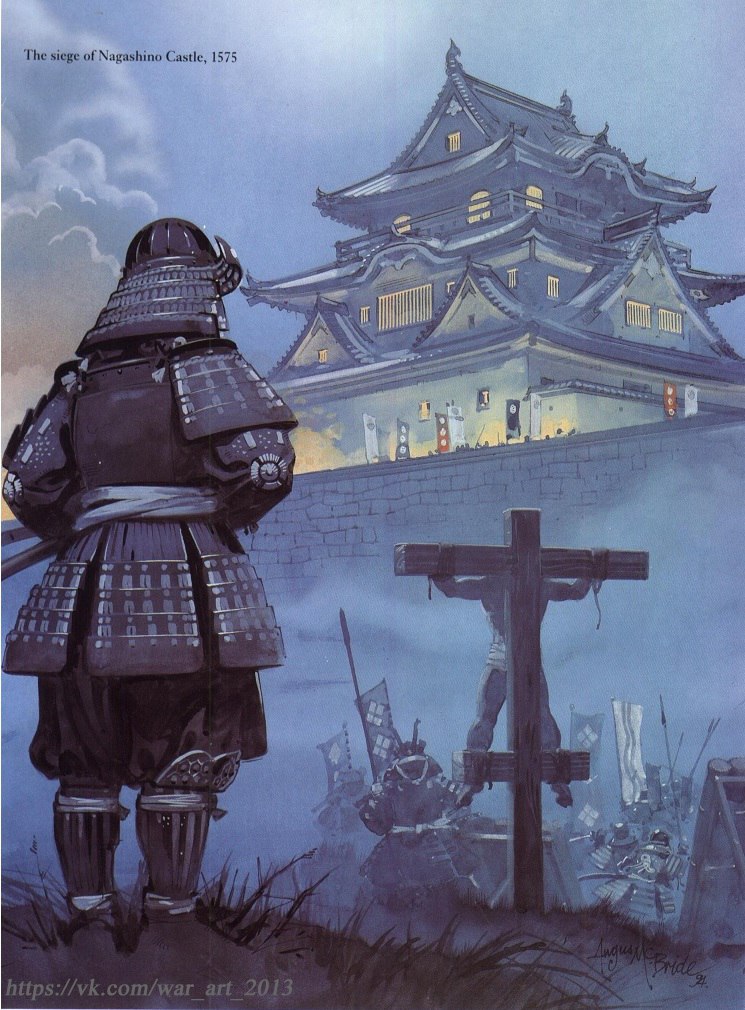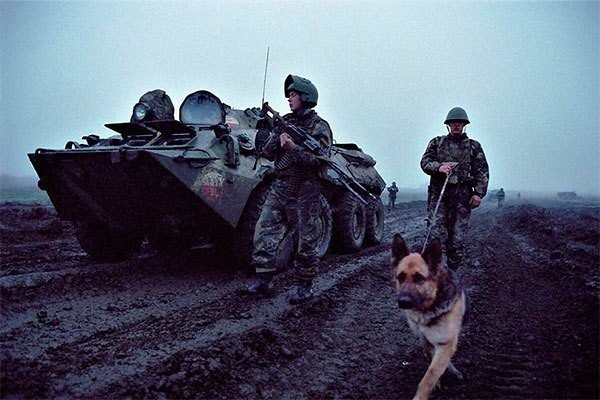“The siege of the castle Nagashino”. Sitaragahara, Japan. 28 June 1575 of the year
автор Angus McBride

In the picture, Takeda's forces are preparing for another assault. On the background, crucified on the cross Samurai Torii Sunemon. Torii was returning from a sortie to the castle, by Takeda troops, to warn deposited on the ambulance by Oda and Tokugawa. However Sunemon was captured by samurai Takeda, having learned that he warned Oda and Tokugawa, Takeda Katsuyori promised to spare his life, if he says that precipitated assistance from the allies do not have to wait (at that time, provisions in the castle remained for three days). Pre-tied to a cross,, and at that moment Torii shouted to the defenders of the castle keep to the last, and that help is on the way. After that, he was immediately pierced with spears (according to other sources and left hanging on the cross as a sign of intimidation of defenders of the castle).
Battle of Nagashino - battle, held 28 June 1575 near the castle, the Nagashino on plain Sitaragahara, where the allied forces of Oda Nobunaga and Tokugawa Ieyasu completely defeated army Takeda Katsuyori. It was one of the most famous battles in the history of the Japanese military, a victory which was achieved thanks to the massive use of firearms. Battle of Nagashino changed traditional methods of warfare in medieval Japan.
Battle of Nagashino was the result of a decade of conflict between the clans Oda and Takeda. AT 1565 the troops of Oda Nobunaga and Shingen's first came together in the eastern lands Mino Province, testified incompatibility interests of each other. Since Takeda territory expansion in this area was not a priority, he settled the conflict, concluding with the Ode Union.
However, 1570 year to form a coalition against Nobunaga Oda has changed. its leader, ninjas Asikaga Yosiaki, I turned to Takeda Shingen proposal to destroy Oda. A pretext for war, Takeda broke the alliance with Nobunaga and 1572 He was moved to the capital at the head of the 25000th troops. At the beginning 1573 at the Battle of Mikatagahara Shingen's army defeated the allied forces of Tokugawa Ieyasu and Oda Nobunaga, However, in May of the same year due to the sudden death of his commander in chief he stopped the attack and returned home.
Although anti-nobunagskaya coalition disintegrated with the liquidation of the Muromachi shogunate in 1573 year, the new head of the clan Takeda, Takeda Kacuëri, I decided to complete the work of his late father and seize the capital of Kyoto. AT 1574 year he launched active operations in the lands of the Tokugawa and Oda, which bordered on his possessions. In February, the Takeda took Akechi castle in the east of Mino Province, and in June - remote mountain fortress Takatendzin in the eastern part of the province of Totomi. These operations were carried out as lightning, that his opponents did not have time to counteract.
In May 1575 of the year, possession of offensive initiative, 15-strong army of Takeda Katsuyori invaded the province of Mikawa, vladenie Ieyasu, and laid siege to the castle Nagashino. His garrison 500 soldiers under the command of the fortress held Okudayry Nobumasy. But after a month, when the stock of provisions came to an end, Commandant sent to Tokugawa overlord messenger, Torii Sune'emona, with a request to send help.
Meanwhile, Tokugawa Ieyasu could not independently resist the forces of Takeda, and therefore I called for reinforcements to Ode Nobunaga. In early June, the 30-thousand troops recently arrived in the province of Mikawa and connect with 5000 Army Ieyasu. Allied forces took up positions in the area Sitaragahara, along the shallow river Rengogava, at 3 Nagashino kilometers west of the castle. On hearing of the approach of a large army of the enemy, led by Oda Nobunaga, commanders kind Takeda advised his commander in chief to withdraw from under the enemy's castle and the defensive. However, the young and impatient Takeda Katsuyori decided to give open battle to the enemy. Leaving for the siege Nagashino 2 thousand. warriors, he led his 13,000th army to Sitaragahara plain.
meanwhile, on the orders of Oda Nobunaga allied forces strengthened their positions. Before the river Rengogava were dug shallow trenches, on the edge of which was erected a palisade defensive sparse in several rows, which served as protection for the infantry by the cavalry attacks. Placed him 3 thousand. arquebusiers. In between detachments lancers were placed between rows of palisade to cover shooters. The line with palisades soldiers Nobunaga sryli hillsides, turning them into cliffs, on top of which were placed archers and the main part of the allies.
Some experienced generals Takeda, seeing, that the enemy was actually erected a well-fortified "lock" on the opposite bank of the river, Katsuyori persuaded not to attack him. They feared a large number of arquebusiers, that, Being on a fence, It was beyond the reach of the elite cavalry Takeda and could inflict a considerable damage. However Katsuyori not listen to this advice, He is relying on his army, which by then it was considered the best standards in all of Japan. Self-confidence he also added that, that lasted for the rainy season, during which, he thought, His enemies could hardly be used matchlock firearms.
28 June 1575 year Oda Nobunaga sent a detachment of 500 arquebusiers behind enemy lines to a pin on the parts, that besiege the castle Nagashino. night with 28 on 29 June this force suddenly attacked 2000th unit Takeda warriors and broke it. Learning about the maneuver forces and the defeat of his Ode siege unit, Takeda Katsuyori immediately decided to storm the position of the allies of Oda and Tokugawa.
29 June 1575 of the year, at six o'clock in the morning, the battle began between the main powers. Elite "Red" cavalry Takeda attacked part of the Tokugawa, based on the fast-break its ranks. However, its assault has choked under the heavy fire of the enemy's arquebusiers, who shot continuously. In spite of the rainy season, the weather was beautiful, which allowed the Allies fully demonstrate the fighting qualities of guns. On the eve of the battle instructed by Portuguese Jesuits Oda Nobunaga ordered arquebusiers line up in rows of three across the front and shoot alternately, replacing single file another. This tactic allowed Nobunaga in Japan for the first time provide a massaging fire, that prejudge the outcome of the battle.
Takeda's vanguard divisions under a hail of bullets arquebus were completely destroyed. Neither of them broke through a barrage of Oda and Tokugawa.
Seeing, that the frontal attack did not produce the desired results, Takeda Katsuyori ordered the rest of the cavalry units go into the enemy's rear flanks, and the infantry - to distract the enemy offensive from the front. However, this plan was unsuccessful. On the right flank cavalry Takeda Rengogava overcame the river and broke the first line of the stockade, but it was immediately repulsed spearmen and arquebusiers Nobunaga. On the left flank coming managed to get to the third row of the stockade, and break into the headquarters of Ieyasu, but this assault has choked, because all the attackers were killed. Offensive infantry also did not make sense - under heavy fire arquebus soldiers Takeda could not break through the enemy defenses and killed en masse, forming piles of corpses.
Losing a third of his troops, Takeda Katsuyori decided to stop the assault and ordered to retreat. Warriors took advantage of Oda and Tokugawa, that came out of the stockade and struck struggled against the enemy. Allied attack caused confusion among the troops retreating Takeda and began to flee. During the chase, the cavalry Nobunaga destroyed another third of the enemy army.
The bout ended Net Allied victory. Katsuyori lost two-thirds of his troops. Among them were 54 outstanding general, that fought more against his father Shingen, as well as the commanders of hundreds of middle and lower rank. Loss of Oda and Tokugawa were less 6 thousand. human.
Winning arquebusiers Oda Nobunaga and Tokugawa Ieyasu over one of the best armies in medieval Japan - Takeda army kind - to demonstrate the advantages of the latest firearms over the old ways of war, based mainly on the use of bladed weapons. Guns were used in samurai battle before, but their role is traditionally underestimated - they are only a secondary weapon. The massive use of arquebus at the Battle of Nagashino demonstrated their murderous power and was the impetus for reform of the then Japanese armies. After 1575 Each year, the provincial governor has created in his mighty army unit arquebusiers, and each next battle starts with gun fire between warring factions. By the middle of XVII century Harquebus along with bow and arrows, He was considered the best weapon of the samurai. Her fighting qualities are now valued well above the spear or sword.
Battle of Nagashino was the last great battle of the genus Takeda, defeat which led to its rapid decline. Having lost a large number of soldiers and talented commanders, stirpes, Kacuëri, He lost his footing in their own domains. FROM 1575 by 1581 year he changed a lot of vassals, that to the side of the neighbors, - birth Uesugi, Go-Hodzё, Lyric and Tokugava. In the end the beginning 1582 the Allied forces of Oda Nobunaga and Tokugawa Ieyasu have launched a major offensive campaign against Takeda and several months put an end to this kind of. In the face of total destruction 3 April 1582 year Katsuyori committed seppuku, together with their wives and children.
https://vk.com/war_art_2013











